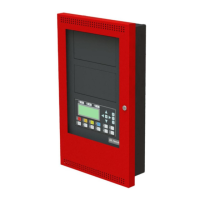193
Using the Configurator
19.36 System/Node/CPU Status
The System Status, Node Status, or CPU Status appear in the Details Pane when you select
the Common System Status, Node & CPU Status, or Annun Status items in the Job Tree.
System Statuses are inputs that can be correlated to outputs. For example:
• Correlate a signal circuit to operate as a power supply (using Init Done).
• Customize the Fire Drill operation.
• Correlate a relay to operate on Reset Command (using Sys Reset).
System Statuses are can also be correlated to LEDs.
System statuses can have three different scopes.
• Common System Status: These statuses have a system wide scope. Examples are
Common Alarm, Fire Drill and Signals Active.
• Node Status: Node Active and AC On are examples of Node Status. When you
choose a Node Status and correlate something to it, you are specifying, for example, the
AC On status of the selected node. The Scope column specifies which node the status
is on.
• CPU Status: These fall into two categories.
• The list view containing the special Annunciator Statuses, Control Enabled, and
Control Disabled appears in the job tree for every CPU that has an LCD (Main
Display and LCD Annunciators).
• The list view containing the other CPU statuses appears in the Job Tree for each
network node and is combined with the Node Statuses. These CPU Statuses are
associated with the main CPU of the node.
Changed by The technician who created the version.
Description The description that was entered when the new job
version was created.
Type • Uploaded: The new job version was a result of a Get
Job.
• New Job: The user created a new version manually.
Status • Locked: The job has been sent to the panel and is
locked against editing.
• Editable: The job is not locked.

